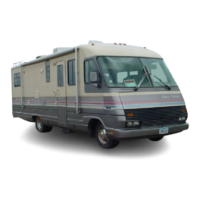50
Discovery, Discovery LXE, Pace Arrow, and Pace Arrow LXEt
MANUAL HEADLAMP AIMING
PROCEDURE
1. Ensure the vehicle is
loaded to “travel and
camping” conditions.
2. Remove all snow, ice, dirt
and other debris that may
affect the ride height of
the vehicle.
3. Find a at area at least the
length of the motorhome
plus 7.62 meters (25
ft) with a vertical at
surface that is at least 3.0
m (10 ft) by 3.0 (10 ft) at
one end (a driveway and
garage door can be used).
4. Measure 7.62 m (25
ft) and position the
motorhome so the
headlamps are 7.62 m
from the vertical at
surface and secure by
placing in park or neutral
and setting the parking
brakes.
5. Verify the headlamp
system to determine if it
is a “Type 1” or “Type 2”
system. A Type 1 system
has a separate HI and
LOW beam and uses four
lamps. A Type 2 system
can be identied by
locating the number “2”
embossed on the lens of
the lamp.
6. Measure the height from
the ground to the center
of the low beam lament
of the driver’s side
headlamp. Project this
height in an exact straight
line to the vertical surface
7.62 m away from the
motorhome. Mark the
height of the lament
and center line on the
vertical surface. This will
have set up a “coordinate
system” for protecting
the headlamp’s beam on
the vertical surface.
7. Repeat step 6 for
the passenger’s side
headlamp.
8. Turn on the headlights.
Using Figure 1 below,
the projected beam on the
vertical surface is to be
located as follows.
A - Type 1 Headlamps:
The projected beam
should be centered
vertically and
horizontally on the
vertical surface as
marked in step 6 and 7.
B - Type 2 Headlamps:
The top edge of the
projected beam is to be
even with a horizontal
line parallel to a line
formed by the two
headlamp lament
centers and to the right of
the vertical center line of
each headlamp.
9. If the headlamps do
not meet the alignment
criteria adjust the
“Vertical” and/or
“Horizontal” positioning
as shown on the attached
gure. Rotate the
adjustment knobs and/or
screws on the headlamp.
When turning the knobs
and/or screws, watch the
direction in which the
projected beam moves to
help understand which
direction on the beam
moves in relation to
turning each.
10. Remember, this
procedure is only a
guideline and is not a
substitute for having
headlamps professionally
aligned.
CAUTION:
The following procedure
is not a substitute for
having the headlamps
professionally aligned
by a certified headlamp
alignment professional to
the Society of Automobile
Engineering standards.
Improper headlamp
alignment may result
in poor
visibility
during
reduced light
conditions
and may
result in an
accident.
020372
Headlamp adjustment
Type 1
Type 2
Headlamp
Vertical
Center
Line
Headlamp
Vertical
Center
Line
Headlamp
Horizontal
Center
Line

